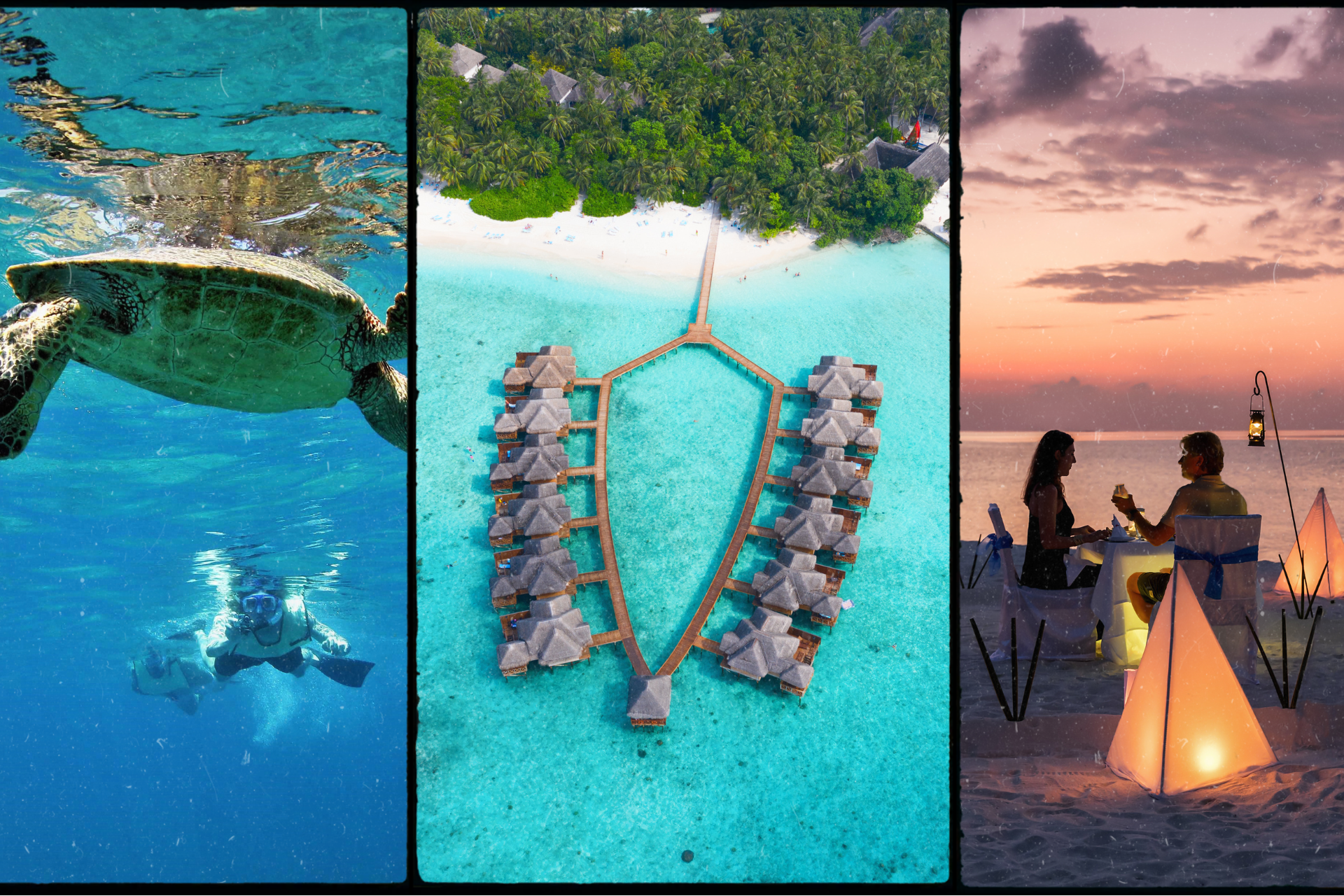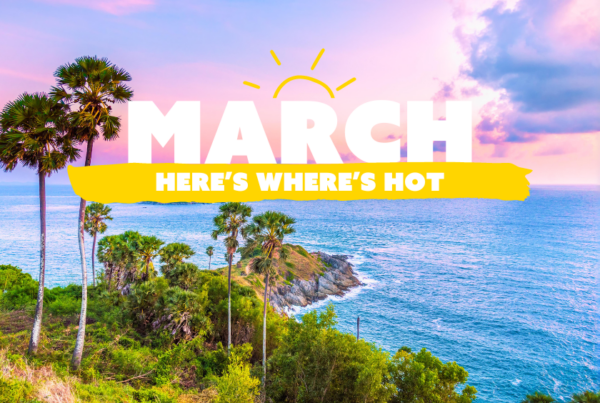Who doesn’t dream about a Maldives honeymoon? We’ve all been there. But depending on when you’re planning to ring those wedding bells, you might find yourself having to either hang fire on your honeymoon (boo) or begin married life with less bliss and more blustery winds (also boo).
When it comes to their weather, the Maldives has a gorgeous season and a…not so gorgeous season. So we’ve put together a quick guide on when and when not to head out there for your honeymoon.
Is the Maldives good for honeymoons?

Is it too obvious to say yes?
Seriously though, the Maldives is one of the biggest honeymoon destinations for some very good reasons. Luxury? Oozes it. Privacy? Just you and the island, baby. Relaxation? So relaxed you’re horizontal. Romantic? Off the charts.
For a lot of people, their honeymoon will be one of those blow-out, go-hard-or-go-home situations where what you really, really want is that postcard perfect experience, and the Maldives are pretty good at it – that is, if you know when to go and what you like to do. It might not look like it from the pictures, but it does, in fact, rain in the Maldives, and at certain times of the year it rains a lot. And not all islands in the Maldives are made alike – some have lolling around on the beach front and centre, whilst others are much more activities focused.
Is 3 nights in the Maldives enough?

It totally depends on what you’re into when it comes to your Maldives honeymoon.
First, you need to choose the right resort. Some have relaxation front, line, and centre. Others go much heavier on the watersports and excursions. Some are mega popular with families, so you have to be prepared to have young children around, whilst others are dreamy couples retreats.
If you’re all about lazing on the beach and swimming in those Gatorade blue waters – basically just pure relaxation – then 3 days is definitely plenty of time. If anything, we’d recommend sticking around for longer! But if you’re the kind of person who loves being a bit of a beach bum but only to a point, and are more interested in making full use of the excursions on offer, like checking out all the local islands (spoiler alert: there’s a lot) then you might find 3 days a bit tight to squeeze everything in.
But if you get itchy feet easily, you don’t necessarily have to do more than 3 days for your Maldives honeymoon – you can always give a twin-centre a go. That’s travel trade lingo for a trip where you tick off two places instead of just one, and they’re particularly good when tied in with a Maldives break. You could have the buzz of a big city like Bangkok or Singapore, followed by pure bliss on white sand beaches. It’s quite literally the best of both worlds.
When to honeymoon in the Maldives based on when you say ‘I do’
Autumn (September, October, November)

Autumn isn’t always the first season that comes to mind when thinking about the date for your wedding, but with warmer temperatures becoming the norm when heading into September these days, an Autumn wedding doesn’t seem so far fetched anymore. Plus, it’s a pretty good time to get hitched if you really want that dreamy Maldives honeymoon.
September and October are the tail end of the wet season, so if you want those cloudless days it might be worth delaying your honeymoon just a little bit, especially if you’re getting married in October as this is a really wet month. But November is lovely here – hot, mostly dry, and averaging a toasty 30 degrees Celsius and higher.
Winter (December, January, February)

If you really fancy that Maldives honeymoon then you might want to plan to say I do in winter as this is when you’ve got your best shot at getting that postcard perfect experience.
December can be a little dicey – it’ll be sunny and dry, but there is a fairly high chances of some pesky clouds showing up. Rain could rock up in the first half of the month too. January sees humidity levels drop further and chances of rain decrease (they’ll be brief and clear up quickly). February, meanwhile, is perfect. It’s the driest month of the year here, the sunniest too. Expect visitor numbers to be on the up around about now, but when you’re tucked away on your resort island you won’t notice this too much.
Spring (March, April, May)

Spring is a classic time to get married, and if you want to exchange vows outside then you’re in luck because spring is another good time for a Maldives honeymoon. It’s actually your last real shot at seeing the islands at their best before the rainy season comes back in summer.
March means surfing season in the Maldives, with long sunny days to while away the hours with only the occasional shower – which, if anything, can make for a nice break from the heat! Another popular month for visitors, expect higher crowds. April is the end of the dry season, so the humidity starts to pick up again, and there’s an increased chance of rain, especially in the second half of the month. May is risky as you’re pretty likely to see rain at least once during your trip! On the flipside, it’ll be quieter and cheaper.
Summer (June, July, August)

Summer in the UK is a gorgeous time to get married. Summer in the Maldives? Not so lovely. Summer is the rainy season here, and the rains don’t really let up until October!
If you’re really desperate to be whisked away, tin cans trailing behind you, straight onto a plane to have that Maldives honeymoon, then you’re best bet is to squeeze it into the first half of July. Any later than that and you’ll most likely have high humidity with the potential for whole days to be lost to rain. Be prepared to make extensive use of your resort’s indoor facilities and not so much time lazing around on the beach. The rainy season’s not great for snorkelling either, as water visibility can be badly affected.
Alternative honeymoon destinations
If the invitations are already out and you’ve realised that you won’t be honeymooning when the Maldives are at their best but don’t fancy waiting around either, here’s a few suggestions that we think make for great Maldives alternatives, whether it’s the watersports you’re after, or just pristine white sand and those clear, clear waters.
The Cook Islands

When it comes to Maldives alternatives, many people jump straight for French Polynesia, but we raise you its just as gorgeous neighbour – the Cook Islands. Nestled between French Polynesia and the American Samoa, the Cook Islands are made up of 15 islands spread out over a pretty vast ocean area. You’ve got the Southern Cook Islands (including Rarotonga and Aitutaki) and the Northern Cook Islands (such as Penrhyn and Manihiki). Rarotonga is the largest and most populous island, serving as the capital.
The islands are known for its deeply rooted Polynesian traditions, like weaving, carving, tattooing, and the hip-shaking movements of their ‘ura’ dance, as well as for their warmth and hospitality. The other thing the Cook Islands are known for is that stunning natural beauty, those crystal-clear turquoise waters, and lots and lots of white sandy beaches nestled along the lush tropical landscapes.
The most well-known spots include Rarotonga, Aitutaki, and Atiu, and each island has its own charms, like Rarotonga’s waterfalls and lush rainforests, Aitukataki’s magnificent lagoon and coral reef, and Atiu’s caves and prehistoric Polynesian villages.
What’s the weather like in the Cook Islands?
There’s a pleasant warm and sunny climate here pretty much all year round. If you’re after the super dry months though, those are from April to November (right when the Maldives are pouring rain!), and you’ll enjoy an average temperature of 26°C.
November to March is the warmer season, when you’ll experience slightly higher humidity and the occasional rainfall – but these are typically brief showers. The temperature ranges between 22°C (min) and 30°C (max). The shoulder months of April, May, September, and October are a great time to visit as the weather is usually the perfect balance of warmer temperatures and drier skies.
Flights to Rarotonga
Mauritius

Mauritius, another jewel of the Indian Ocean, is a classic and another great alternative to a Maldives honeymoon.
Characterized by its stunning natural landscapes, including sandy beaches, coral reefs, waterfalls, volcanic craters, and lush forests, some of the island’s notable natural attractions include exploring lush tropical gardens, visiting stunning waterfalls like Chamarel and Rochester Falls, hiking in Black River Gorges National Park, and checking out the unique landscapes of Seven Colored Earths. Loads to see and do, clearly, which is why we recommend it if you need more than just perfect beaches (it’s got those too) on your honeymoon.
We especially recommend it if you’re into watersports, because Mauritius is known for being pretty good at ’em. The island is surrounded by coral reefs teeming with colourful fish, making it an excellent destination for snorkelling, with extra popular spots being Blue Bay Marine Park, Trou aux Biches, and Pointe aux Piments. There’s dive centres across the island too, where you can explore coral gardens, underwater caves, and shipwrecks, including the famous Stella Maru wreck and the Cathedral dive site near Flic en Flac. Plus, handy trade winds and calm lagoons make Mauritius a mecca for windsurfers and kitesurfers. Le Morne Peninsula is especially renowned for its ideal wind conditions and flatwater spots like One Eye and Manawa.
Mauritius is also a little easier to reach than the Cook Islands, with direct flights from the UK available with British Airways and Air Mauritius.
What’s the weather like in Mauritius?
Mauritius experiences a classic tropical climate with warm weather pretty much year-round. Even in winter, the temperatures only really drop from hot to balmy. But the very best time to visit Mauritius is from May to December when the weather is on the cooler side, dry and sunny.
May is the official start of winter, but the temperatures stay in the comfortable mid-range and the humidity lifts too. The strong trade winds start to kick in now, great if you’re into your kite surfing. July is one of the coolest months (still warm by our standards) but if you stick to the north of the island you’ll still have lovely temperatures.
August is ideal for sunny days without the intense heat, and no rain. September is the start of the high season, with even warmer temperatures but weaker winds, but October is the driest month on the island if you want to be certain of no rain. In the Maldives October is the wettest month!





